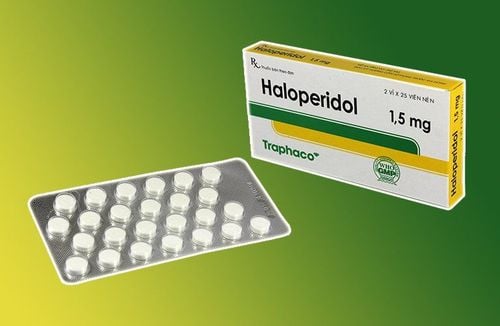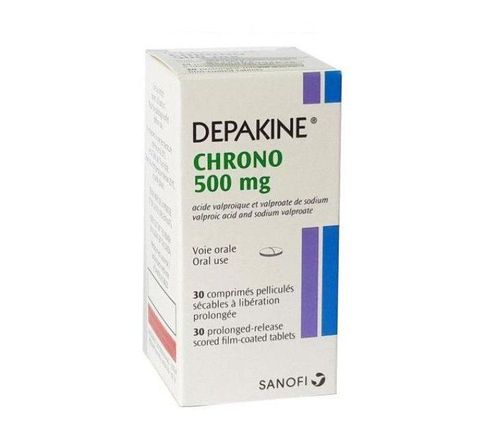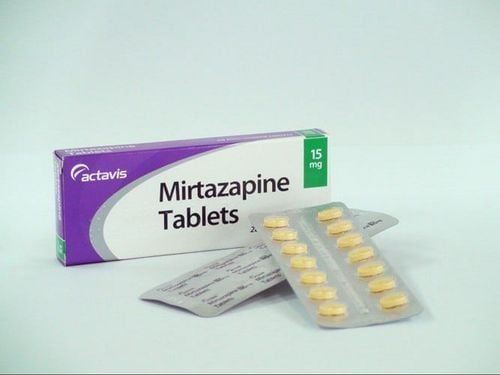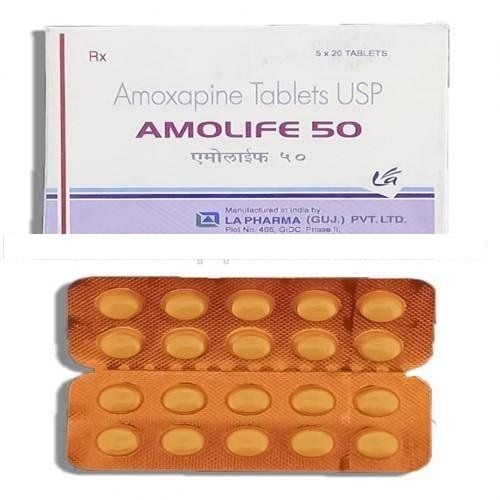This is an automatically translated article.
What effect does Olangim 10mg have on the nervous system? In fact, Olangim 10mg is effective in the treatment of psychosis, specifically schizophrenia and moderate to severe mania in patients associated with bipolar disorder.
1. What are the effects of Olangim 10mg?
Olangim 10mg belongs to the group of antipsychotics, the main ingredient is Olanzapine 10mg. Olanzapine, which acts in the treatment of psychosis by combining antagonism on the drug's receptors for dopamine and serotonin SHT2. Olangim 10mg tablets are indicated for the treatment of schizophrenia and moderate to severe manic syndrome associated with bipolar disorder.
2. Usage and dosage of Olangim 10mg
Olangim 10mg is taken orally, taken with water and can be taken with or without meals. Dosage of Olangim in adults (over 18 years of age) for each specific treatment purpose is as follows:
Schizophrenia: The recommended starting dose is 5 - 10 mg/time/day, which can be increased to 10 mg / time / day after a few days of taking the drug. The dose of Olangim 10 mg should only be increased when each course of treatment is spaced at least 1 week apart. The 10 mg dose should be administered only after the patient has been clinically evaluated. The maximum dose should not exceed 20mg/day and the recommended maintenance dose is 10-20mg/time/day. Mania: Olangim 10mg monotherapy, recommended starting at 10-15mg/time/day, can be increased to 5mg/day. The maintenance dose is from 5 to 20mg/time/day and the maximum is 20mg/day. The recommended starting dose in combination with lithium valproate is 10 mg once daily and may range from 5 to 20 mg/day. For the prevention of recurrent mania, the recommended starting dose is 10 mg/day. The dose of Olangim 10mg for some other subjects is noted as follows:
Patients with moderate hepatic and renal impairment: Starting dose of 5mg/day, when increasing the dose should be cautious. Elderly patients: Depending on clinical characteristics, appropriate dosage is indicated, usually not less than 5mg/day. Gender, smokers: No dosage adjustment is required. Dose reduction should only be considered when there is a factor that slows drug metabolism and caution should be exercised when increasing the dose. Olangim 10mg overdose is a very common condition with manifestations such as tachycardia, dysarthria, aggression, anxiety, extrapyramidal symptoms, decreased level of consciousness, coma. Some cases of overdose with a lower rate can cause increased or decreased blood pressure, cardiac arrhythmias, convulsions, delirium or coma, malignant sedative syndrome, respiratory depression, cardiopulmonary arrest.
For Olangim 10mg overdose, there is no specific antidote yet. The patient is not recommended to induce vomiting, instead, to remove the drug from the body, it is necessary to apply gastric lavage or use activated charcoal, which also reduces the bioavailability of the drug.
3. Side effects of Olangim 10mg
Olangim 10mg may cause some unwanted side effects with the frequency of occurrence as follows:
Common: Dry mouth, appetite, weight gain, nausea, vomiting, indigestion, constipation. Chest pain, hypotension, tachycardia, peripheral edema. Insomnia, somnolence, nightmares, dizziness, forgetfulness, mania, euphoria, extrapyramidal syndrome, fever, speech disturbance. Increased ALT, burning on the skin, decreased vision, tremors, easy falls, muscle weakness. In case the patient experiences side effects of neuroleptic malignant syndrome after taking Olangim 10mg, it is necessary to stop the drug immediately and give active supportive treatment, and closely monitor. After that, if you want to take the drug again, you need to be careful and choose a drug with less effect.
In case patients experience tardive dyskinesia side effects when taking Olangim 10mg, it is necessary to reduce the dose and stop the drug. In case of drowsiness as a side effect, it is necessary to reduce the dose or use it only once a day.
If the patient exhibits dyslipidemia after taking the drug, it is necessary to consider the use of other sedatives to avoid affecting the lipid metabolism in the body more.
4. Some notes when taking Olangim 10mg
Do not use Olangim 10mg in people with hypersensitivity to the ingredients of the drug, pregnant or lactating women, patients at risk of narrow-angle glaucoma. Monitor patients after taking Olangim 10mg for several days to several weeks, as this is the time for clinical improvement. People with mental disorders related to behavioral disorders or dementia should not take Olangim 10mg, because the risk of cerebrovascular accident and death is increased. People with Parkinson's disease should not take Olangim 10mg to treat psychosis, because the disease can get worse and increase the risk of hallucinations, the drug is also not as effective as other drugs. Olangim 10mg should be discontinued immediately at the onset of neuroleptic malignant syndrome such as changes in blood pressure and heart rate, sweating, high fever, muscle spasticity, mental changes, acute renal failure, increased creatinine phosphokinase. Monitor patients with diabetes when taking Olangim 10mg, because the disease is likely to get worse, possibly even causing coma and death. Weight and blood sugar should be monitored regularly. Control dyslipidemia in patients taking Olangim 10mg in particular and antipsychotics in general, because the disease may progress more severely. Patients with neutropenia or a history of bone marrow suppression due to chemotherapy or radiation therapy, patients with acid leukocytosis or bone marrow hyperplasia should use Olangim 10mg with caution Elderly, people with medical conditions. Congenital prolongation of the QT interval or other cardiovascular diseases such as cardiac hypertrophy, congestive heart failure, hypokalemia and hypomagnesemia require caution when taking Olangim 10mg. Preventive assessment and risk assessment of venous thrombosis should be assessed in patients with schizophrenia with other risk factors when taking Olangim 10 mg. Long-term use of Olangim 10mg may increase the risk of tardive dyskinesia. When symptoms are observed, dose reduction or discontinuation should be considered. People with a history of convulsions should be cautious when using Olangim 10mg. In some cases, Olangim 10mg can cause tachycardia, orthostatic hypotension, dizziness, unconsciousness, especially in the early stages of taking the drug. In addition, patients also face the risk of sudden death if cardiovascular disease is associated with the drug. People with liver failure or a history of impaired liver function, liver toxicity due to drugs should be cautious when using Olangim 10mg and need to be evaluated for liver enzymes periodically. Patients who are dehydrated, taking anticholinergic drugs, or exercising strenuously, exposed to strong heat sources should be cautious when using Olangim 10mg because the drug makes the drug unable to regulate body temperature. People at risk of aspiration pneumonia should use caution when using Olangim 10mg, because the drug may increase the risk of decreased esophageal motility, difficulty swallowing, especially in Alzheimer's patients. Closely monitor patients with bipolar disorder, schizophrenia while taking Olangim 10mg to avoid the risk of suicide. People with prostate enlargement (benign), narrow-angle glaucoma or people with a history of paralytic ileus due to anticholinergic drugs should be cautious when using Olangim 10mg. During the use of Olangim 10mg, it is necessary to avoid taking the drug with alcohol or other drugs that affect the central nervous system. Patients with galactose intolerance, glucose-galactose malabsorption or lactose deficiency should not take Olangim 10mg. Use caution when driving or operating or operating machinery while taking Olangim 10mg because it can cause dizziness, somnolence, impaired motor skills, thinking or judgment. Pregnant women should not take Olangim 10mg, because data on this group of subjects are limited. Women who are breastfeeding should stop breastfeeding if they want to take the drug. If used together with Olangim 10mg with valproate can reduce neutrophils; with other drugs that increase the risk of QT prolongation; with inhibitors that affect the concentration of the affected drug; with tobacco increases the metabolism of planzapine. The use of Olangim 10mg is to treat schizophrenia and moderate and severe manic syndrome in patients associated with bipolar disorder.
Please dial HOTLINE for more information or register for an appointment HERE. Download MyVinmec app to make appointments faster and to manage your bookings easily.













